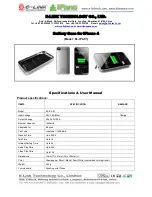
For Your Safety
110
In 1996, the FCC, working with the FDA, the U.S. Environmental Protection
Agency, and other agencies, established RF exposure safety guidelines for
wireless phones in the United States. Before a wireless phone model is
available for sale to the public, it must be tested by the manufacturer and
certified to the FCC that it does not exceed limits established by the FCC.
One of these limits is expressed as a Specific Absorption Rate, or “SAR.”
SAR is a measure of the rate of absorption of RF energy in the body. Tests
for SAR are conducted with the phone transmitting at its highest power
level in all tested frequency bands. Since 1996, the FCC has required that
the SAR of handheld wireless phones not exceed 1.6 watts per kilogram,
averaged over one gram of tissue.
Although the SAR is determined at the highest power level, the actual SAR
value of a wireless phone while operating can be less than the reported
SAR value. This is because the SAR value may vary from call to call,
depending on factors such as proximity to a cell site, the proximity of the
phone to the body while in use, and the use of hands-free devices. For more
information about SARs, see the FCC’s OET Bulletins 56 and 65 at http://
www.fcc.gov/Bureaus/Engineering_Technology/Documents/bulletins or visit
the Cellular Telecom munications Industry Association website at http://
www.ctia.org/consumer_info/index.cfm/AID/10371. You may also wish to
contact the manufacturer of your phone.
Can I minimize my RF exposure?
If you are concerned about RF, there are several simple steps you can take
to minimize your RF exposure. You can, of course, reduce your talk time.
You can place more distance between your body and the source of the
Summary of Contents for L17AG
Page 16: ...Features you will love Features you will love ...
Page 19: ...Basics Basics ...
Page 21: ...Basics 20 Phone layout Headset Jack Microphone Earpiece Front Camera Lens ...
Page 47: ...Apps Apps ...
Page 75: ...Settings 74 Settings Settings ...
Page 95: ...Appendix Appendix ...
Page 104: ...For Your Safety For Your Safety ...
Page 146: ......















































